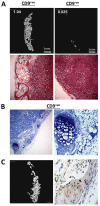Tetraspanin CD9 and ectonucleotidase CD73 identify an osteochondroprogenitor population with elevated osteogenic properties
- PMID: 25564652
- PMCID: PMC4302994
- DOI: 10.1242/dev.113571
Tetraspanin CD9 and ectonucleotidase CD73 identify an osteochondroprogenitor population with elevated osteogenic properties
Abstract
Cell-based bone regeneration strategies offer promise for traumatic bone injuries, congenital defects, non-union fractures and other skeletal pathologies. Postnatal bone remodeling and fracture healing provide evidence that an osteochondroprogenitor cell is present in adult life that can differentiate to remodel or repair the fractured bone. However, cell-based skeletal repair in the clinic is still in its infancy, mostly due to poor characterization of progenitor cells and lack of knowledge about their in vivo behavior. Here, we took a combined approach of high-throughput screening, flow-based cell sorting and in vivo transplantation to isolate markers that identify osteochondroprogenitor cells. We show that the presence of tetraspanin CD9 enriches for osteochondroprogenitors within CD105(+) mesenchymal cells and that these cells readily form bone upon transplantation. In addition, we have used Thy1.2 and the ectonucleotidase CD73 to identify subsets within the CD9(+) population that lead to endochondral or intramembranous-like bone formation. Utilization of this unique cell surface phenotype to enrich for osteochondroprogenitor cells will allow for further characterization of the molecular mechanisms that regulate their osteogenic properties.
Keywords: Osteoblast; Osteochondroprogenitor; Skeletal stem cell.
© 2015. Published by The Company of Biologists Ltd.
Figures




Similar articles
-
Characterization of mesenchymal stem cell subpopulations from human amniotic membrane with dissimilar osteoblastic potential.Stem Cells Dev. 2013 Apr 15;22(8):1275-87. doi: 10.1089/scd.2012.0359. Epub 2013 Jan 29. Stem Cells Dev. 2013. PMID: 23211052
-
Osteoblast precursors, but not mature osteoblasts, move into developing and fractured bones along with invading blood vessels.Dev Cell. 2010 Aug 17;19(2):329-44. doi: 10.1016/j.devcel.2010.07.010. Dev Cell. 2010. PMID: 20708594 Free PMC article.
-
Ecto-5'-nucleotidase (CD73) regulates bone formation and remodeling during intramembranous bone repair in aging mice.Tissue Cell. 2017 Oct;49(5):545-551. doi: 10.1016/j.tice.2017.07.001. Epub 2017 Jul 4. Tissue Cell. 2017. PMID: 28720305 Free PMC article.
-
Skeletal stem cells and bone regeneration: translational strategies from bench to clinic.Proc Inst Mech Eng H. 2010 Dec;224(12):1455-70. doi: 10.1243/09544119JEIM750. Proc Inst Mech Eng H. 2010. PMID: 21287831 Review.
-
Osteoblast recruitment to sites of bone formation in skeletal development, homeostasis, and regeneration.Birth Defects Res C Embryo Today. 2013 Sep;99(3):170-91. doi: 10.1002/bdrc.21047. Birth Defects Res C Embryo Today. 2013. PMID: 24078495 Review.
Cited by
-
A single cell transcriptional atlas of early synovial joint development.Development. 2020 Jul 20;147(14):dev185777. doi: 10.1242/dev.185777. Development. 2020. PMID: 32580935 Free PMC article.
-
Mesothelin/mucin 16 signaling in activated portal fibroblasts regulates cholestatic liver fibrosis.J Clin Invest. 2017 Apr 3;127(4):1254-1270. doi: 10.1172/JCI88845. Epub 2017 Mar 13. J Clin Invest. 2017. PMID: 28287406 Free PMC article.
-
Atrophic nonunion stromal cells form bone and recreate the bone marrow environment in vivo.OTA Int. 2018 Dec 18;1(3):e008. doi: 10.1097/OI9.0000000000000008. eCollection 2018 Dec. OTA Int. 2018. PMID: 33937646 Free PMC article.
-
Extracellular Vesicles Derived from Osteogenic-Differentiated Human Bone Marrow-Derived Mesenchymal Cells Rescue Osteogenic Ability of Bone Marrow-Derived Mesenchymal Cells Impaired by Hypoxia.Biomedicines. 2023 Oct 16;11(10):2804. doi: 10.3390/biomedicines11102804. Biomedicines. 2023. PMID: 37893177 Free PMC article.
-
Candidates for Intra-Articular Administration Therapeutics and Therapies of Osteoarthritis.Int J Mol Sci. 2021 Mar 30;22(7):3594. doi: 10.3390/ijms22073594. Int J Mol Sci. 2021. PMID: 33808364 Free PMC article. Review.
References
Publication types
MeSH terms
Substances
Associated data
- Actions
Grants and funding
LinkOut - more resources
Full Text Sources
Other Literature Sources
Medical
Molecular Biology Databases
Research Materials
Miscellaneous

